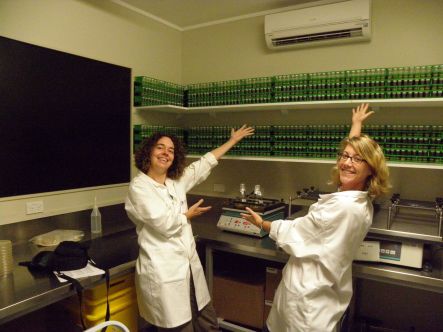
Katrin Hammerschmidt, left, and Caroline Rose with some of the bacterial cultures they grow for their experiments (image: Rainey group)
Why would a single-celled organism give up its ability to reproduce for the pleasure of being part of a larger, more complex structure?
This is one of the big questions of evolutionary biology, and Massey University evolutionary geneticist Paul Rainey and his team (post-docs Katrin Hammerschmidt and Eric Libby and PhD student Caroline Rose) are trying to find some answers with the help of a well-studied soil bacterium.
When cultured in the laboratory, some cells develop the ability to produce a sticky glue that holds them together in a thin mat, floating at the top of the liquid broth they live in.
Producing the glue is costly to individual cells, but the cost is outweighed by the benefits of group membership which ensures access to oxygen at the surface. However, the mats are short-lived. Eventually, a new type of cell emerges which doesn't produce the glue but still takes advantage of the group benefits.
These cheats prosper and ultimately weaken the mat to the point of collapse, to just then produce the adhesive again and start a new mat. The team proposes that the cheats are the equivalent of a reproductive cell starting a new generation and that the experiments illustrate one way of how single cells may have developed into more complex groups and organisms.

